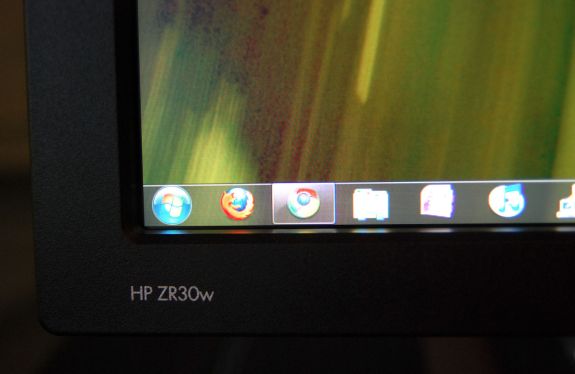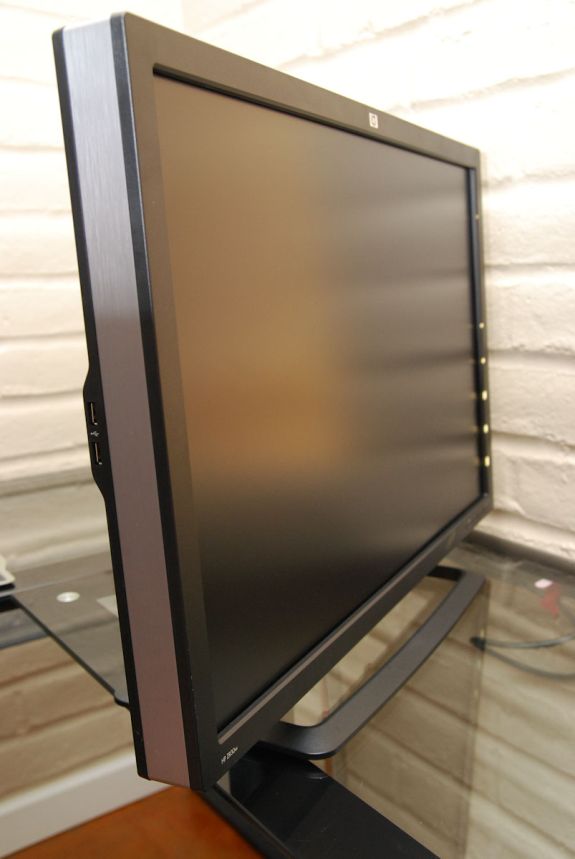A New 30" Contender: HP ZR30w Review
by Brian Klug on June 1, 2010 6:30 PM EST
Opining for an OSD
As I mentioned before, there’s no OSD to speak of. The only options exposed to users are input selection, brightness, and dynamic contrast. A blue LED at right flashes three times when you’ve reached the upper or lower brightness limits, and flashes four times when dynamic contrast is turned on, once when turned off. The LED is off when the display is in operation, and amber when in standby. The rest is up to you.
Spartan Scaling Selections
I also already touched on scaling which appears to be pretty barebones for reasons discussed earlier. You can pixel double by going with 1280x800, or go for native, or choose another resolution and everything upscaled with some smudging. There's no 1:1 option, or any options whatsoever. Honestly, I can’t think of any reasons why you wouldn’t drive an LCD at anything other than native resolution. The dot pitch of the ZR30w is fabulous at 0.250 mm, if you’re paying for those pixels, use them, then use DPI controls in the operating system if text and UI is too small. The ZR30w does scale other aspect ratios that I tested properly, but don't expect too much. Honestly it still makes no sense to drive a display this high resolution at anything but native.
Final Thoughts
The 30” segment of the LCD market demands the best of the best. It’s indisputably the ring in which every manufacturer wages battle with its flagship monitor. Solid execution here usually translates to solid performance for smaller size panels in the same lineup. Suffice it to say that HP’s 30 inch ZR series successor to the LP3065 doesn’t disappoint.
Spartan Scaling Selections
I also already touched on scaling which appears to be pretty barebones for reasons discussed earlier. You can pixel double by going with 1280x800, or go for native, or choose another resolution and everything upscaled with some smudging. There's no 1:1 option, or any options whatsoever. Honestly, I can’t think of any reasons why you wouldn’t drive an LCD at anything other than native resolution. The dot pitch of the ZR30w is fabulous at 0.250 mm, if you’re paying for those pixels, use them, then use DPI controls in the operating system if text and UI is too small. The ZR30w does scale other aspect ratios that I tested properly, but don't expect too much. Honestly it still makes no sense to drive a display this high resolution at anything but native.
Final Thoughts
The 30” segment of the LCD market demands the best of the best. It’s indisputably the ring in which every manufacturer wages battle with its flagship monitor. Solid execution here usually translates to solid performance for smaller size panels in the same lineup. Suffice it to say that HP’s 30 inch ZR series successor to the LP3065 doesn’t disappoint.
We would’ve liked to see just a bit more color accuracy, but the tradeoff for a dramatically bigger gamut is a good one to make. The ZR30w blew past the advertised 99% of AdobeRGB, coming in at just over 111% of the volume. It’s important to note that HP likely means coverage overlap of 99%, which the ZR30w does meet. But heck, having a volume bigger than the AdobeRGB volume is more notable. In person, the ZR30w is impressive all around. It’s bright, contrasty, and has colors that put my daily use monitors and others I’ve got laying around to shame; not an easy thing to do.
At an MSRP of $1,299, the ZR30w is priced aggressively and below its predecessor and competition. If you don’t mind lacking an extra DVI port, the increase in gamut volume is a notable difference. It’s likely that both lack of an OSD as well as accessory VGA, HDMI, component or composite inputs is related to the lack of a compatible control IC. Instead, there’s likely a simple scaler so we see minimal processing lag for an IPS panel, and unfortunately minimal user control. This is a bold move on HP’s part to continue for a second generation, but likely keeps cost and input processing lag low.
At an MSRP of $1,299, the ZR30w is priced aggressively and below its predecessor and competition. If you don’t mind lacking an extra DVI port, the increase in gamut volume is a notable difference. It’s likely that both lack of an OSD as well as accessory VGA, HDMI, component or composite inputs is related to the lack of a compatible control IC. Instead, there’s likely a simple scaler so we see minimal processing lag for an IPS panel, and unfortunately minimal user control. This is a bold move on HP’s part to continue for a second generation, but likely keeps cost and input processing lag low.
Interestingly enough, this is definitely the way that things are going for display controls, with a growing number offering DDC control as the exclusive option for tweaking settings. In practice, what HP offers with the front controls is almost all you need, so long as you can calibrate to your liking in software. Perhaps we might have gotten under a Delta E of 1.0 with some RGB sliders, but who’s to say?
The ZR30w is definitely a serious contender among 30” displays. It’s an attractive package that wows with above average color tracking, an impressive gamut, and a competitive price, but lacks some of the extra “accessory” inputs that consumers are starting to demand. That said, it looks like the ZR30w is a solid option if you’re looking for a 30” display with an unbeatable color gamut.












95 Comments
View All Comments
prof.yustas - Tuesday, June 1, 2010 - link
Thanks for the review, but I think most people would be more interested to see a review of HP ZR24w. Are you planning to review it?Brian Klug - Tuesday, June 1, 2010 - link
Hey, yeah we're definitely working on getting the ZR 22" and 24" displays for review. I know that everyone is very excited for us to get those and start working on em - at least I know I am! Should be within the month.Cheers,
Brian
kenyee - Tuesday, June 22, 2010 - link
Only negative is it doesn't do 1:1 display of 1080p inputs...it scales it up to 1200 lines all the time. A bunch of ZR24W owners have filed bugs w/ HP, but no word on getting this fixed yet :-PIf Anand could check this and gripe as well, it might help :-)
CSMR - Tuesday, June 1, 2010 - link
Good review, useful data.I do think the input options are just right for this: DVI+displayport. This is a PC monitor so these are the right options. Devices that use hdmi (consumer electronics, smartphones etc.) generally can't output 2560x1600.
icrf - Tuesday, June 1, 2010 - link
Yeah, but my personal Dell 3007 WFP-HC's DVI-D only means I can't hook up my work Dell M6400 laptop, as it has VGA and DP outputs only. I need a docking station for the two to mate, though I can't convince myself or the office that it's a worthy expense.More inputs is always better, even if there are downsides to the others (clarity, lag, etc).
softdrinkviking - Tuesday, June 1, 2010 - link
while i agree that added connectivity is always a good thing,if the lack of extra inputs shaved a $100 off the price, then it's why i, and a lot of other folks will buy one.
GoodBytes - Tuesday, June 1, 2010 - link
Display Port can be converted easily with an adapter to HDMI (with audio if your laptop supports audio with DP) or even DVI without any difficulties. And the adapters are fairly cheap and small.erple2 - Wednesday, June 2, 2010 - link
Does HDMI even have the bandwidth to support the native resolution? I don't think so - it's limited to at most 1920x1200.It therefore makes perfect sense to me to not include an HDMI connector.
platinum__1 - Tuesday, July 13, 2010 - link
As of HDMI 1.3 the max resolution is 2560x1600p at a 30 bit pixel depth. HDMI 1.4 will do 2k and 4k over single link to a resolution of 4096x2160p at up to 36bit pixel depth. (referenced from wikipedia for concise comparison charts). That is not to say that any given HDMI output to a device, or for that matter, a display port adapter will be able to deliver it due to the individual ports build, but it is possible under the right circumstances.samhall - Monday, January 9, 2012 - link
just wondering if anyone knows how to connect an xbox up to this monitor. I have connected it by getting an addapter for the DVI-D port but cant get anything on the screen.Can someone help Please??????